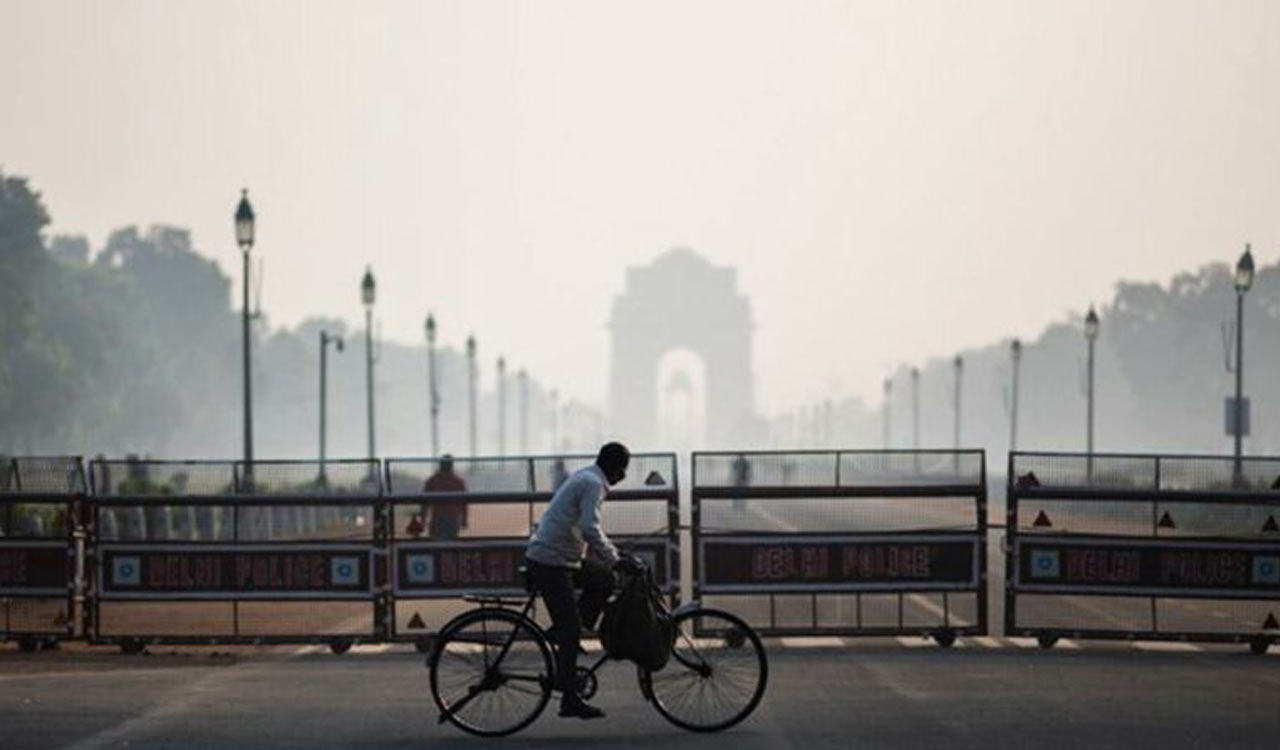Delhi’s air quality deteriorated to the ‘very poor’ category on Saturday due to slow wind speed at night and a dip in the temperatures
Published Date – 05:41 PM, Mon – 30 October 23

File Photo
New Delhi: Air pollution levels entered the ‘severe’ zone in parts of Delhi on Monday while the overall air quality index (AQI) in the city stood in the ‘very poor’ category for the third consecutive day, according to weather-monitoring agencies.
The city’s 24-hour average AQI was recorded at 347 at 4 pm, worsening from 325 on Sunday, 304 on Saturday and 261 (poor) on Friday, according to the Central Pollution Control Board (CPCB).
It was 256 on Thursday, 243 on Wednesday and 220 on Tuesday.
Rohini (406), Wazirpur (416), and Mundka (414) recorded their air quality in the ‘severe’ zone (AQI above 400).
The AQI was 272 in neighbouring Ghaziabad, 300 in Faridabad, 203 in Gurugram, 303 in Noida and 336 in Greater Noida.
An AQI between zero and 50 is considered ‘good’, 51 and 100 ‘satisfactory’, 101 and 200 ‘moderate’, 201 and 300 ‘poor’, 301 and 400 ‘very poor’, and 401 and 500 ‘severe’.
The city’s air quality deteriorated to the ‘very poor’ category on Saturday due to slow wind speed at night and a dip in the temperatures.
The air quality is expected to remain ‘very poor’ for a few more days, according to the Centre’s Air Quality Early Warning System for Delhi.
The capital’s air quality in October 2023 has been worse compared to the last two years and meteorologists attribute it to the lack of rainfall.
Delhi Environment Minister Gopal Rai Sunday said that though the number of stubble-burning incidents in Punjab has reduced, vehicular emissions have emerged as a major contributor to the air pollution in the city.
He demanded that the Centre impose a strict ban on buses operating with poor-quality diesel in the National Capital Region (NCR) areas of Haryana, Uttar Pradesh and Rajasthan.
Starting November 1, only electric, CNG and BS VI-compliant diesel buses will be allowed to operate between Delhi and the cities and towns of Haryana, Uttar Pradesh and Rajasthan falling within the NCR, according to directions issued by the Centre’s Commission for Air Quality Management (CAQM).
In an effort to reduce pollution levels, the Centre announced in April 2020 that all vehicles sold in India must comply with the Bharat Stage VI (BS-VI) emission standards.
The Bharat Stage emission standards set legal limits on the amount of air pollutants such as carbon monoxide and particulate matter that vehicles in India can emit. These standards focus on improving emission control, fuel efficiency and engine design.
As vehicle manufacturers provide vehicles that meet these new norms, oil companies supply fuel that adheres to the BS-VI standards, known as the world’s cleanest fuel.
Unfavourable meteorological conditions and a cocktail of emissions from firecrackers and paddy-straw burning, in addition to local sources of pollution, push the Delhi-NCR’s air quality to hazardous levels during winter.
According to an analysis conducted by the Delhi Pollution Control Committee (DPCC), the capital experiences peak pollution from November 1 to November 15, when the number of stubble-burning incidents in Punjab and Haryana go up.
The Delhi government launched a 15-point action plan last month to mitigate air pollution during the winter season, with a strong emphasis on addressing dust pollution, vehicular emissions and open burning of garbage.
Special drives to check dust, vehicular and industrial pollution are already underway in the city.
In keeping with the practice of the last three years, the Delhi government last month announced a comprehensive ban on the manufacture, storage, sale and use of firecrackers within the city.
A public awareness campaign — “Patakhe Nahi Diye Jalao” — will soon be reintroduced to discourage bursting firecrackers.
The government has also prepared a mitigation plan for each of the 13 identified pollution hotspots — Narela, Bawana, Mundka, Wazirpur, Rohini, R K Puram, Okhla, Jahangirpuri, Anand Vihar, Vivek Vihar, Punjabi Bagh, Mayapuri and Dwarka.
Rai recently said the government has identified eight more pollution hotspots, in addition to the existing 13, in the national capital and special teams will be deployed at these places to check the pollution sources.
He said the government has also decided to use suppressant powder to prevent dust pollution.
Dust suppressants could include chemical agents like calcium chloride, magnesium chloride, lignosulfonates and various polymers. These chemicals work by attracting and binding fine dust particles together, making them too heavy to become airborne.





